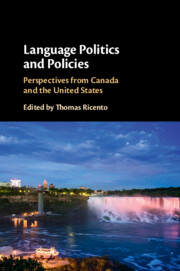Book contents
- Language Politics and Policies
- Language Politics and Policies
- Copyright page
- Dedication
- Contents
- Figures
- Tables
- Contributors
- Preface
- Contributor Personal Statements
- Introduction
- Part I Theoretical Orientations
- Part II The United States Context
- Part III The Canadian Context
- 11 Heritage Language Education Policies and the Regulation of Racial and Linguistic Difference in Ontario
- 12 A Foucauldian Approach to Language Policy in Canada
- 13 Promises, Acts, and Action
- 14 Language, Land, and Stewardship
- 15 A Land of Immigration and Official French–English Bilingualism
- 16 Ethnocultural and Linguistic Diversity
- Index
- References
14 - Language, Land, and Stewardship
Indigenous Imperatives and Canadian Policy
from Part III - The Canadian Context
Published online by Cambridge University Press: 18 July 2019
- Language Politics and Policies
- Language Politics and Policies
- Copyright page
- Dedication
- Contents
- Figures
- Tables
- Contributors
- Preface
- Contributor Personal Statements
- Introduction
- Part I Theoretical Orientations
- Part II The United States Context
- Part III The Canadian Context
- 11 Heritage Language Education Policies and the Regulation of Racial and Linguistic Difference in Ontario
- 12 A Foucauldian Approach to Language Policy in Canada
- 13 Promises, Acts, and Action
- 14 Language, Land, and Stewardship
- 15 A Land of Immigration and Official French–English Bilingualism
- 16 Ethnocultural and Linguistic Diversity
- Index
- References
Summary
The Indigenous languages of North America once constituted the entire human linguistic landscape of the continent, and played a vital role in the early relationships between Indigenous peoples and European explorers and traders. In the modern national era, however, those languages have been relegated to a footnote, and the few efforts to include them in legislation and policy have done little to change their marginal status. In this chapter I examine the increasing prominence of linguistic issues in Indigenous political and cultural movements in North America, together with relevant aspirational declarations and policy statements. From this foundation, I argue that reconciliation, as a political and social process aimed at achieving greater parity and justice between Indigenous and settler peoples in North America, offers more promising grounds, ontologically, epistemologically, and ethically, for the management of language diversity in general, and suggest some specific policy directions for more detailed exploration.
Keywords
- Type
- Chapter
- Information
- Language Politics and PoliciesPerspectives from Canada and the United States, pp. 263 - 280Publisher: Cambridge University PressPrint publication year: 2019
References
- 1
- Cited by



